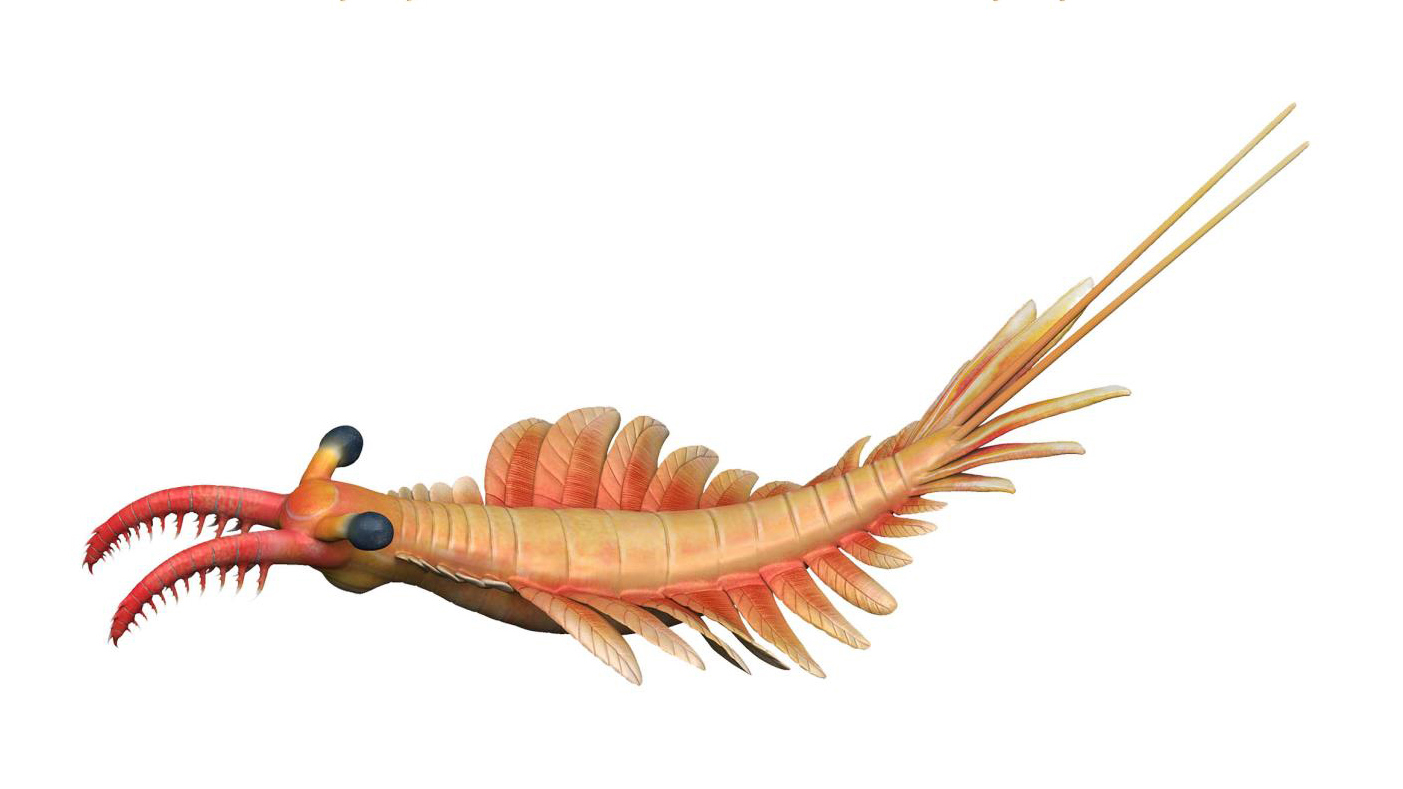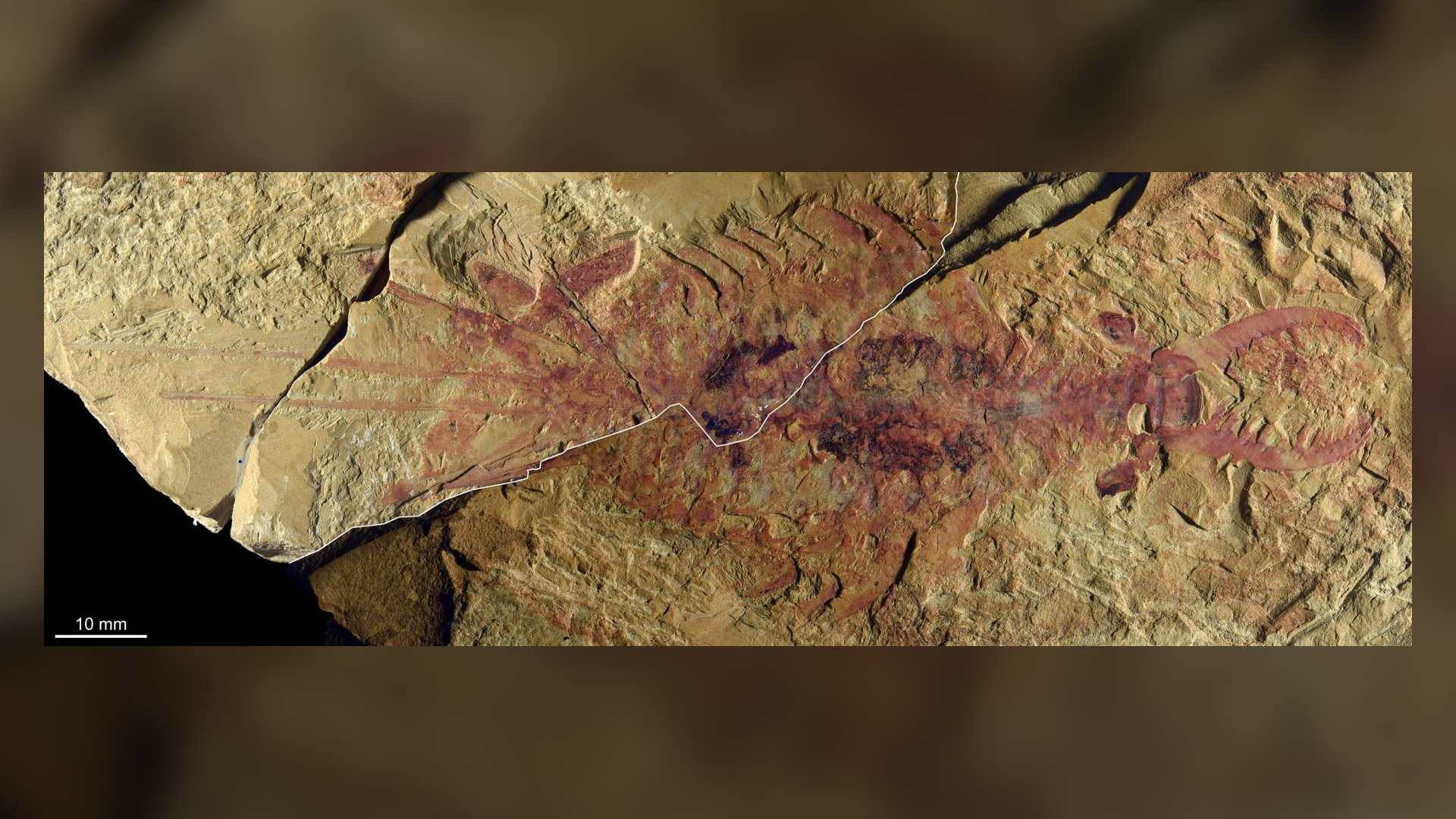Ancient and bizarre 'innovation crab' from China had eyes on stalks, spike-studded arms and a tail full of 'blades'
A bizarre fossil from China's Chengjiang Lagerstätte site hints at early diversity in a group of Cambrian marine arthropods called radiodonts.

Imagine a creature shaped somewhat like a toilet brush scuttling along the seafloor around 500 million years ago, near what is now southwestern China. Now picture that toilet brush with eyes bobbing on stalks; a pair of spike-lined armlike appendages; and a tail fan with long, sweeping blades, and you'll have a pretty good image of a newly described animal weirdo that lived during the Cambrian period (541 million to 485.4 million years ago).
Scientists found the fossil specimens — one of which was a near-complete youngster — in 1990 in the Chengjiang Lagerstätte, a site in China's Yunnan province. The juvenile individual measured nearly 6 inches (15 centimeters) long and about 2 inches (5 cm) wide, and belongs to a group of extinct ocean-dwelling ancestral arthropods called radiodonts, researchers reported Sept. 7 in the Journal of the Geological Society.
Initially, researchers identified the oddball animal as a previously known radiodont species. (The group gets its name from the circular ring of teeth surrounding the animals' mouths.) However, the fossil's frontmost pair of spiky limbs — known as raptorial appendages — differed from all other radiodonts', which led to a recent reevaluation of the fossils, said lead study author Han Zeng, an assistant professor at the Nanjing Institute of Geology and Paleontology at the Chinese Academy of Sciences.
Though radiodonts have similar body plans, species "are distinguished mainly by their diverse forms of raptorial appendages," and those of the fossil were so unique that researchers determined it was not only a new species but a previously unknown genus, Zeng told Live Science in an email.
Related: The 'weirdest wonder' of evolution had an even weirder cousin, new study finds
They dubbed the strange species Innovatiocaris maotianshanensis, with the genus name coming from the Latin words for "innovation" and "crab" and the species name referencing Maotianshan, the location in Chengjiang where the fossils were discovered, according to the study. When it lived, the species was one of the ocean's most fearsome predators; in fact, radiodonts are among the oldest giant apex predators on Earth, Zeng said.

"Their appearance in the ~520 million-years-ago early Cambrian indicated the formation of complex food webs and marine ecosystems," he explained. "Besides their ecological importance, Radiodonta have a very bizarre morphology that has puzzled scientists for over a century since their first fossil discoveries in [the] 1880s."
Sign up for the Live Science daily newsletter now
Get the world’s most fascinating discoveries delivered straight to your inbox.
Radiodonts are shaped so strangely that, for decades, their isolated body parts were identified by paleontologists as belonging to a wide range of animal groups. Some of this newly described animal's unusual radiodont relatives had backward-facing mouths and claw-tipped trunks, while others looked like the Millennium Falcon in the "Star Wars" movies or sucked up prey like a Roomba.
It wasn't until the 1980s, when scientists found the first complete radiodont fossils, that researchers finally resolved their classification of the group "as an ancestral lineage of arthropods," Zeng said.
In I. maotianshanensis, "the spinous raptorial appendages indicate predation of relatively large prey," while its large eyes hint that it had good vision, Zeng said. Gills and flaps along its trunk were probably used for breathing and swimming, while tail structures helped it turn and maneuver. "Overall, these body structures made this animal an active predator," Zeng said.
I. maotianshanensis offers intriguing new clues about these elusive and peculiar arthropod ancestors. But with every new fossil radiodont discovery, new questions emerge about the group's ecology and evolution over their 120 million-year history, such as how many species there were, how they hunted and fed on their ocean prey, and how they evolved, Zeng said.
As a newfound genus, "Innovatiocaris suggests the presence of a new evolutionary lineage among Radiodonta," hinting that there is still much to be unearthed about the group's diversity and evolutionary history, Zeng told Live Science. "Upcoming new fossils of Radiodonta will certainly tell us more," he said.

Mindy Weisberger is an editor at Scholastic and a former Live Science channel editor and senior writer. She has reported on general science, covering climate change, paleontology, biology and space. Mindy studied film at Columbia University; prior to Live Science she produced, wrote and directed media for the American Museum of Natural History in New York City. Her videos about dinosaurs, astrophysics, biodiversity and evolution appear in museums and science centers worldwide, earning awards such as the CINE Golden Eagle and the Communicator Award of Excellence. Her writing has also appeared in Scientific American, The Washington Post and How It Works Magazine. Her book "Rise of the Zombie Bugs: The Surprising Science of Parasitic Mind Control" will be published in spring 2025 by Johns Hopkins University Press.










